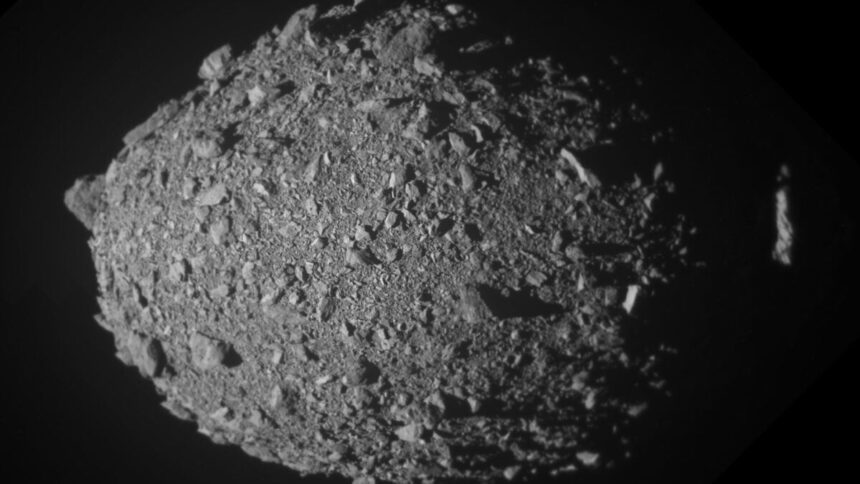In 2022, NASA rammed a spacecraft into an asteroid to see if it could alter its orbital period around its parent asteroid. The mission, dubbed the Double Asteroid Redirection Test (DART), aimed to determine whether humanity could theoretically save itself from a catastrophic asteroid impact.
DART collided with Dimorphos, a small moonlet orbiting a larger asteroid called Didymos, on September 26, 2022. The results of the impact blew NASA’s expectations out of the water, shortening Dimorphos’s orbital period by 32 minutes. Such a change would be more than enough to deflect a dangerous asteroid away from Earth, indicating that this strategy—the kinetic impactor technique—could save us if necessary. New research, however, complicates this success story. An investigation into the debris DART left behind suggests this technique, when applied to planetary defense, isn’t as straightforward as scientists initially thought.
“We succeeded in deflecting an asteroid, moving it from its orbit,” said study lead author Tony Farnham, a research astronomer at the University of Maryland, in a statement. “Our research shows that while the direct impact of the DART spacecraft caused this change, the boulders ejected gave an additional kick that was almost as big. That additional factor changes the physics we need to consider when planning these types of missions.” Farnham and his colleagues published their findings in The Planetary Science Journal on July 4.
Dimorphos is a “rubble pile” asteroid, a loose conglomeration of material such as rocks, pebbles, and boulders held together by gravity. This study only applies to this type of asteroid. Had DART collided with a more coherent, solid body, the impact wouldn’t have produced these bizarre effects. Still, there are plenty of other rubble pile asteroids in the galaxy, so understanding how they respond to the kinetic impactor technique is important.
The researchers analyzed images taken by LICIACube, an Italian Space Agency satellite that was mounted on the DART spacecraft. About two weeks before the impact, LICIACube separated and began following about three minutes behind the spacecraft, allowing the satellite to beam images of the collision and its effects back to Earth. In addition to observing the crater DART punched into the surface of Dimorphos, LICIACube captured the ejecta plume, or the cloud of debris ejected from the asteroid when DART hit it.
These images allowed Farnham and his colleagues to track 104 boulders ranging from 1.3 to 23.6 feet (0.4 to 7.2 meters) wide. The rocks shot away from the asteroid at speeds up to 116 miles per hour (187 kilometers per hour). Strangely, the distribution of this ejected debris was not random, defying the researchers’ expectations.
“We saw that the boulders weren’t scattered randomly in space,” Farnham said. “Instead, they were clustered in two pretty distinct groups, with an absence of material elsewhere, which means that something unknown is at work here.”
The larger of the two clusters, which contained 70% of the debris, shot southward away from the asteroid at high speeds and shallow angles. The researchers believe these objects came from a specific source on Dimorphos—perhaps two large boulders called Atabaque and Bodhran that shattered when DART’s solar panels slammed into them moments before the main body of the spacecraft hit.
When the team compared this outcome to that of NASA’s Deep Impact (EPOXI) mission, which punched a probe into a comet to study its interior structure, the distribution of the debris made more sense. Whereas Deep Impact hit a surface made up of very small, uniform particles, DART hit a rocky surface packed with large boulders. This “resulted in chaotic and filamentary structures in its ejecta patterns,” coauthor Jessica Sunshine, a professor of astronomy and geology at the University of Maryland who served as principal investigator for Deep Impact, explained in the statement.
“Comparing these two missions side-by-side gives us this insight into how different types of celestial bodies respond to impacts, which is crucial to ensuring that a planetary defense mission is successful,” she said.
The 104 ejected boulders carried a total kinetic energy equal to 1.4% of the energy of the DART spacecraft, and 96% of that energy was directed to the south, representing “significant momentum contributions that were not accounted for in the orbital period measurements,” the researchers state in their report. The force of debris exploding away from Dimorphos upon DART’s impact could have tilted the asteroid’s orbital plane by up to one degree, potentially causing it to tumble erratically in space.
“Thus, a full accounting of the momentum in all directions and understanding the role played by surface boulders will provide better knowledge of how the specifics of the impact could alter—either reducing or enhancing—the effects of a kinetic impactor,” the researchers write.
Astronomers have catalogued roughly 2,500 potentially hazardous asteroids in our corner of the galaxy. These are space rocks that can come alarmingly close to Earth and are large enough to cause significant damage upon impact. While there is currently no known risk of one of these asteroids hitting our planet within the next century, developing strategies to prevent such a catastrophe could someday prove lifesaving. The success of the DART mission suggests that NASA is on the right track, but this new study shows we still have much to learn about the effects of the kinetic impactor technique.
Read the full article here











